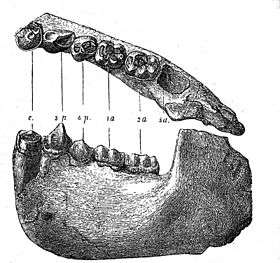Dryopithecus fontani
| Dryopithecus fontani Temporal range: Miocene | |
|---|---|
 | |
| Jaw of Dryopithecus fontani | |
| Scientific classification | |
| Kingdom: | Animalia |
| Phylum: | Chordata |
| Class: | Mammalia |
| Order: | Primates |
| Superfamily: | Hominoidea |
| Family: | Hominidae |
| Subfamily: | Homininae |
| Tribe: | Dryopithecini |
| Genus: | Dryopithecus |
| Species: | D. fontani |
| Binomial name | |
| Dryopithecus fontani Lartet, 1856 | |
Dryopithecus fontani is an extinct ape that was first discovered in Saint-Gaudens, Haute-Garonne, France, in the 19th century, and was dated to the middle Miocene.
Morphology
Dryopithecus fontani had a dental formula of 2:1:2:3 on both the upper and lower jaw. The incisors of this species were relatively narrow and less spatulate compared to other genera such as Proconsul. The upper molars of this species had a partly developed lingual cingulum. Dryopithecus fontani had relatively long upper premolars and relatively broad lower premolars. The lower molars had the Y5 pattern, which is also called the Dryopithecus pattern. The cheek had a thin layer of enamel on them and there were low, rounded cusps. This species had gracile canines and a short premaxilla. The mandible of Dryopithecus fontani had an inferior transverse torus but lacked a superior transverse torus. The forelimbs of this species had a reduced olecranon process, a deep humeral trochlea, and the loss of the entepicondylar foramen. Dryopithecus fontani had an average body mass of around 35.0 kilograms. [1]
Range
Dryopithecus fontani has been found through the continent of Europe, in locations such as Spain and Hungary. [1]
Diet
Based upon dental morphology Dryopithecus fontani was a frugivorous species. [1]
Notes
References
- Flannery, Sean (November 2001). "Dryopithecus fontani". Retrieved November 2010. Check date values in:
|access-date=(help)
External links
- Hawk, John. "Dryopithecus::overview". Retrieved November 2010. Check date values in:
|access-date=(help)